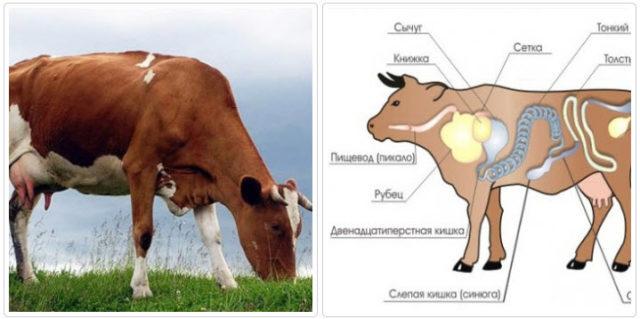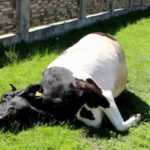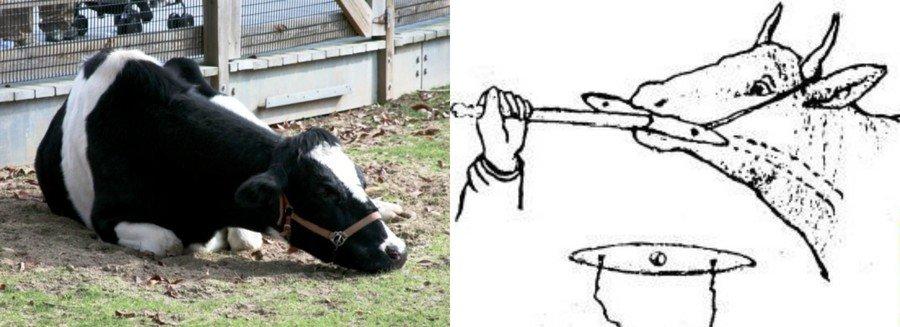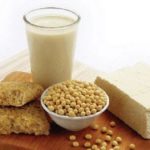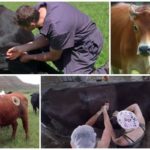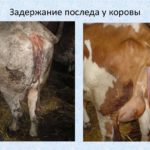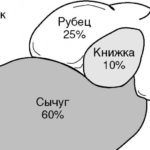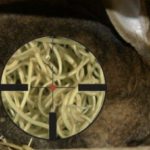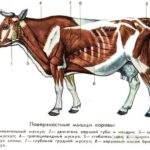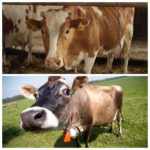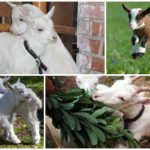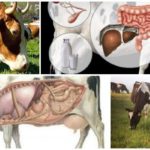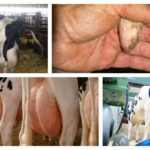Blockage of part of the esophagus in cattle often takes inexperienced owners by surprise. The disease develops rapidly, and any delay threatens the animal’s death. Anxiety, a strained cough, and excessive salivation signal impending trouble. In such cases, the help of an experienced veterinarian is necessary. The specialist will determine the cause of the pet’s deterioration and provide emergency assistance.
What is it?
Primary blockage of the upper gastrointestinal tract is an accidental blockage of the lumen of the animal's esophagus.A foreign body or large pieces of food act as a plug. An accident entails complete or partial blockage of the stomach. If the object turns out to be significantly larger than the lumen in the pet’s stomach, the animal’s esophagus begins to involuntarily contract. This mechanism is designed by nature to independently rid the pet of foreign objects in the gastrointestinal tract. As a result of reflex actions, large pieces of food move along the excretory tract of the digestive tract.
Unfortunately, it is rare for a pet to get rid of foreign objects naturally. In most cases, contractions of the upper sections of the stomach lead to inflammation of the walls of the esophagus, so it is impossible to delay treatment of the animal.
Causes of esophageal blockage in cattle
The cause of a dangerous phenomenon can be random factors, serious illnesses or human negligence.
- Animals eating large pieces of pumpkin, root vegetables, unchopped corn cobs, large amounts of cake and other inappropriate food. This kind of trouble often happens with hungry pets. Animals frantically swallow food without grinding it.
- Cows are often victims of accidents. Horned pets need constant mineral supplements. Lack of additives leads to cows ingesting random objects.
- Sometimes the cause of gastric blockage is a narrowing of the esophagus. Pathology occurs due to damage to the walls of the stomach. Actively growing tumors lead to injury. The formations compress the digestive organ, and the lumen is completely blocked. Tuberculosis or leukemia lead to a similar effect.Numerous lymph nodes injure the gastric mucosa and block the gap.
- Paralysis of the esophagus often leads to disruption of the gastrointestinal tract. The cause of collapse may be rabies, central paralysis or organ bruise.
Symptoms of the disease
Changes in your pet's behavior and well-being occur suddenly.
- The animal tries to make swallowing movements. In this way, the pet tries to push the stuck lump further along the esophagus.
- Persistent urge to vomit.
- Heavy salivation. Due to the lack of chewing gum, the pet continues to work with its jaws in vain.
- Convulsive, paroxysmal cough.
- The pet is worried, waving its tail, moaning. Sometimes he tries to hit his abdomen with his limbs.
- If a foreign object gets stuck in the cervical esophagus, the affected area becomes swollen. A spherical compaction is clearly palpable in the area of the left jugular groove. After a few minutes, the tumor becomes inflamed and begins to cause pain to the animal.
- If the lumen is only partially blocked, the pet can drink water and belch accumulated gases. In case of complete blockage of the digestive organ, gases accumulate in the animal’s body. In this case, the pet develops tympany.
- Some individuals, even with complete blockage of the organ, try to eat food and drink water. Unable to pass through the esophagus, the fluid rushes back and splashes out through the pet's nasal passages. The same story happens with food. However, in this case, food may settle in the stomach above the blocked area.
Rules for treating a cow
To determine an accurate diagnosis, the cow is examined. First of all, the specialist examines the jugular groove and determines the degree of enlargement and swelling of the organ.The doctor carefully feels the pet’s neck, running his fingers along the entire length of the jugular recess. In this way, a random object stuck in the upper part of the esophagus is detected.
In other cases, the probing method is used. The tool is selected in accordance with the weight of the animal. The procedure allows you to push through a stuck foreign body and release accumulated gases. In difficult cases, veterinarians resort to x-rays or esophagoscopy. If the upper part of the stomach is completely blocked, emergency intervention is necessary. Otherwise, the cow will die from asphyxia. Treatment methods depend on the location of the foreign body in the pet’s gastrointestinal tract.
In order to remove the stuck object, the cow is securely tied to a support or tree. During the procedure, the animal's mouth must remain open, so a spacer - a wedge - is inserted between the pet's teeth. The foreign body is removed from the cow's esophagus using a towel-wrapped hand or a probe. Using an instrument, the object is pushed to the excretory tract of the gastrointestinal tract. The procedure is done with caution, otherwise the stomach may be injured.
In mild cases, the stuck object is removed by vomiting. To do this, pet's neck is stroked in the area of the jugular groove. Hands move towards the cow's head. This activates the gag reflex. To facilitate the procedure, the cow is given 0.5 cups of vegetable oil.
In extremely severe cases, surgery (esophagotomy) is performed.
Folk remedies and recipes
After removing a foreign object, the pet's gastrointestinal tract needs help. Proven folk methods will help to improve the functioning of organs:
- A decoction of chamomile, yarrow or flax seed.To prepare the product, brew 25-30 g of herb in 1 liter of boiling water. The drink is simmered in a water bath for 30 minutes. After cooling, the product is filtered and given to the pet for 2 days.
- In some cases, gentle massage of the hungry pit helps to cope with the problem. The procedure is done using a fist.
- Yeast drink. To prepare the product, dissolve 150 yeast in 1.5 cups of warm boiled water and leave to infuse for 30 minutes. Meanwhile, mix 0.5 cups of vodka and 100 g of sugar. Yeast infusion is added to the resulting mixture. As a result of preparation, 1 liter of the drug is obtained. The medicine is given to the animal a couple of times a day. The course of treatment lasts 2 days. It should be remembered that the yeast drink is given to the pet only after removing the foreign object from the esophagus.
Why is blockage dangerous?
Blockage of the upper stomach is fatal for the animal. If assistance is not provided in a timely manner, the animal may experience inflammation of the mucous membrane of the esophagus, swelling of the scar and tissue necrosis. The rapid development of the disease leads to inflammation of the lungs, compression of the heart and asphyxia. If rescue measures are taken within the first hours, disaster can be prevented.
Prevention
Responsible animal feeding helps avoid problems. Competent farmers do not allow horned animals to graze near potato and beet fields. Large root vegetables and corn cobs intended for animal feeding must be chopped. The pasture and place where livestock are kept are regularly inspected. All foreign objects are removed. Animals' diets must include vitamin and mineral supplements. Special licking salt is placed in the feeder.

